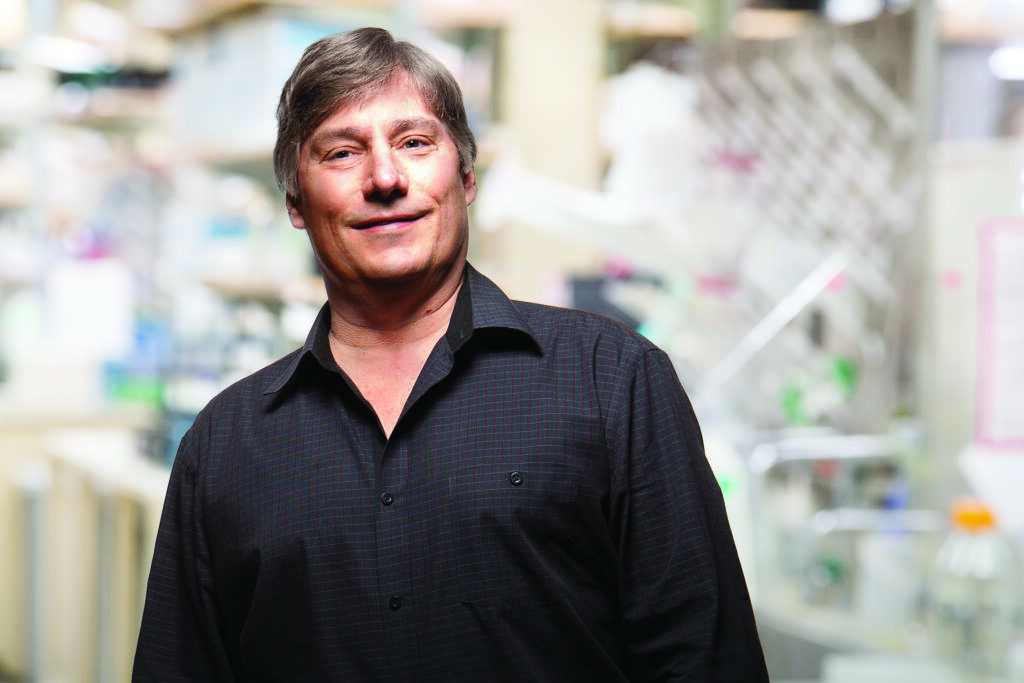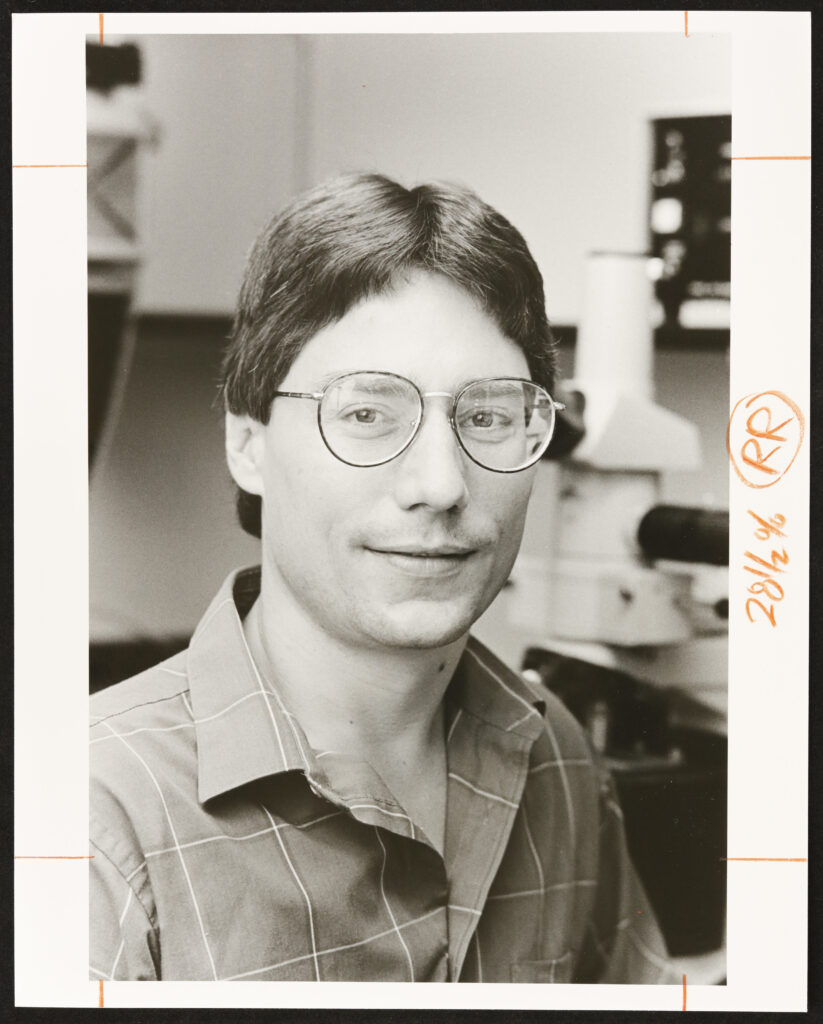O’Leary was a leader in brain development who was a professor at the Salk Institute for Biological Studies for nearly three decades.

Dennis D.M. O’Leary, who earned his PhD in neural sciences in 1983 at Washington University School of Medicine in St. Louis, recently passed away. After working as a postdoctoral fellow and research assistant professor at the Salk Institute for Biological Studies, O’Leary returned to WashU Medicine in 1986 as an assistant professor in the Department of Neurological Surgery. He also held joint appointments in the departments of Anatomy and Neurobiology (which was renamed the Department of Neuroscience in 2016) and Neurology. He was promoted to associate professor of neuroscience with tenure in the Department of Anatomy and Neurobiology in 1990.
O’Leary returned to the Salk Institutute in 1990, where he served on the faculty until 2017, when he became professor emeritus.
O’Leary’s laboratory at WashU used in vivo tracing and surgical implants, along with sophisticated experimental designs in vitro, to study embryonic neural organization. These experiments helped define important principles of cortical development underlying areal differentiation and interstitial axonal branching.
“When Dennis joined our department, he brought a great passion for studying neuroscience, as well as energy and enthusiasm,” said Paul H. Taghert, PhD, professor of neuroscience, who worked alongside O’Leary at WashU. “He inspired outstanding work by others while also helping make this a fun place to work.”
Andreas Burkhalter, PhD, professor of neuroscience, also worked alongside O’Leary at WashU, as their labs neighbored each other in the McMillan Building.
“Dennis stood out as a superb experimentalist, effective communicator of scientific ideas and talented tactician to shape a debate,” Burkhalter said.
Burkhalter said O’Leary investigated how, during architectonical and functional development, distinct areas of the cortex emerge from a largely uniform neuroepithelium. O’Leary theorized that this process was largely driven by external signals transmitted by the thalamocortical input and asserted that area-specific cues are not predetermined by genetic mechanisms in a protomap within the neuroepithelium but are instructed postmitotically by external factors acting in the subplate of protocortex.

(Credit: Bernard Becker Medical Library)
“As Dennis’ work drilled deeper, a more nuanced picture emerged, in which cortical patterning develops by the interplay between genetic and extrinsic mechanisms,” Burkhalter said. “The new results softened Dennis’ resistance to the protomap model, and he began to revise his thinking.”
O’Leary used mouse mutants with spatially distinct expression patterns of transcription factors and found that progenitor cells carry axial information, supporting the protomap model of early cortical arealization.
“Despite this transformative insight, it was too early to put his favored protocortex model to rest,” Burkhalter said. “He was keen to find out whether genetic ablation of thalamocortical inputs affected the patterning of areas. With a clever experimental design and skillful implementation, he found what he wanted to see for so many years. Largely through Dennis’ work, we have come to think that cortical arealization is a serial process in which intrinsic and extrinsic factors contribute to area-specific cell types and circuits. This vignette of the impactful work of my admired colleague shows Dennis’ compassion, experimental creativity and scientific integrity.”
Beyond being a thought leader, O’Leary was known as an inspirational mentor. He hosted many talented trainees at Washington University who have gone on to notable careers in neuroscience and neurology, including Brad Schlaggar, MD, PhD (president and CEO of the Kennedy Krieger Institute), Su Koester, PhD (acting deputy director of the National Institute of Mental Health) and David K. Simon, MD, PhD (professor of neurology, Harvard Medical School).
O’Leary joined the Salk Institute as an associate professor in the Molecular Neurobiology Laboratory and was promoted to professor in 1993. He also was an associate adjunct professor and then adjunct professor at the University of California San Diego School of Medicine.
At Salk, his group began incorporating genetic and molecular approaches to complement their successful cellular methods of studying cortical development.
“Dennis was an outstanding neuroscientist and a leading light in the field of developmental neurobiology,” said Gerald Joyce, MD, PhD, president of the Salk Institute, in an internal message. “Over his career, he addressed questions about brain development to better understand the genes and molecules that not only help neurons form and find their place in a developing brain but also play key roles in neural function and health throughout life.”
At both WashU and the Salk Institute, Dennis and his wife, Lora, helped create social networks that welcomed his lab members and members from neighboring labs.
Among his mentees at the Salk Institute was Linda Richards, PhD, the Edison Professor and chair of the Department of Neuroscience. Richards worked as a postdoctoral fellow in O’Leary’s laboratory at Salk.
“Dennis’ work had a profound impact on the field of cortical development,” she said. “He trained many leaders in the field and impressed upon all his trainees the importance of supporting the Society for Neurosciencethrough regular attendance at the annual meeting. He was a former president of the Cajal Club and will be missed by his former lab members, friends and colleagues.”
O’Leary was often honored for his pioneering work, including being named a fellow of the American Association for the Advancement of Science in 2003 and elected as a member of the American Academy of Arts & Sciences in 2015.
The American Academy of Arts & Sciences noted that O’Leary made fundamental discoveries in the field, such as identifying cellular and molecular mechanisms for developing topographic maps and defining diverse mechanisms that control the patterning of the cerebral cortex. He also determined “that neural connections in the vertebrate central nervous system arise from branches that form de novo from the primary axon shaft days after it passed its targets forming initially exuberant axonal projections followed by large-scale, selective axon pruning independent of neuronal death.”
O’Leary’s thesis advisor at WashU was W. Maxwell Cowan, MD, DPhil, who served as chair of the Department of Anatomy and Neurobiology from 1968 to 1980 and who Nature Neuroscience called “one of the founders of modern neural science.”
The Salk Institute message noted that beyond O’Leary’s passion for science, he was a fan of the “San Diego Padres and Chargers, as well as the Chicago Bulls, and he rode motocross bikes competitively. Dennis’ other love was his three children, in whom he had great pride.”